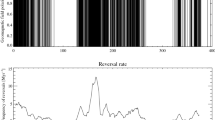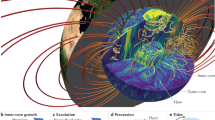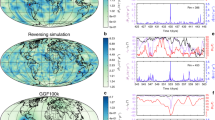Abstract
A striking feature of many natural dynamos is their ability to undergo polarity reversals1,2. The best documented example is Earth’s magnetic field, which has reversed hundreds of times during its history3,4. The origin of geomagnetic polarity reversals lies in a magnetohydrodynamic process that takes place in Earth’s core, but the precise mechanism is debated5. The majority of numerical geodynamo simulations that exhibit reversals operate in a regime in which the viscosity of the fluid remains important, and in which the dynamo mechanism primarily involves stretching and twisting of field lines by columnar convection6. Here we present an example of another class of reversing-geodynamo model, which operates in a regime of comparatively low viscosity and high magnetic diffusivity. This class does not fit into the paradigm of reversal regimes that are dictated by the value of the local Rossby number (the ratio of advection to Coriolis force)7,8. Instead, stretching of the magnetic field by a strong shear in the east–west flow near the imaginary cylinder just touching the inner core and parallel to the axis of rotation is crucial to the reversal mechanism in our models, which involves a process akin to kinematic dynamo waves9,10. Because our results are relevant in a regime of low viscosity and high magnetic diffusivity, and with geophysically appropriate boundary conditions, this form of dynamo wave may also be involved in geomagnetic reversals.
This is a preview of subscription content, access via your institution
Access options
Subscribe to this journal
Receive 51 print issues and online access
$199.00 per year
only $3.90 per issue
Buy this article
- Purchase on Springer Link
- Instant access to full article PDF
Prices may be subject to local taxes which are calculated during checkout




Similar content being viewed by others
References
Moffatt, H. K. Field Generation in Electrically Conducting Fluids (Cambridge Univ. Press, 1978)
Parker, E. N. Cosmical Magnetic fields: Their Origin and Their Activity (Oxford Univ. Press, 1979)
Jacobs, J. A. Reversals of the Earth’s Magnetic Field (Cambridge Univ. Press, 1994)
Merrill, R. T. & McFadden, P. L. Geomagnetic polarity transitions. Rev. Geophys. 37, 201–226 (1999)
Pétrélis, F. & Fauve, S. Mechanisms for magnetic field reversals. Philos. Trans. R. Soc. Lond. A 368, 1595–1605 (2010)
Olson, P., Driscoll, P. & Amit, H. Dipole collapse and reversal precursors in a numerical dynamo. Phys. Earth Planet. Inter. 173, 121–140 (2009)
Christensen, U. & Aubert, J. Scaling properties of convection-driven dynamos in rotating spherical shells and application to planetary magnetic fields. Geophys. J. Int . 166, 97–114 (2006)
Olson, P. & Amit, H. Magnetic reversal frequency scaling in dynamos with thermochemical convection. Phys. Earth Planet. Inter. 229, 122–133 (2014)
Parker, E. N. Hydromagnetic dynamo models. Astrophys. J. 122, 293–314 (1955)
Busse, F. H. & Simitev, R. D. Parameter dependences of convection-driven dynamos in rotating spherical fluid shells. Geophys. Astrophys. Fluid Dyn. 100, 341–361 (2006)
Christensen, U. R. & Wicht, J. in Treatise on Geophysics 2nd edn (ed. Schubert, G. ) Vol. 8, 245–277 (Elsevier, 2015)
Roberts, P. H. & King, E. M. On the genesis of the Earth’s magnetism. Rep. Prog. Phys. 76, 096801 (2013)
Kida, S., Araki, K. & Kitauchi, H. Periodic reversals of magnetic field generated by thermal convection in a rotating spherical shell. J. Phys. Soc. Jpn 66, 2194–2201 (1997)
Sarson, G. R. Reversal models from dynamo calculations. Philos. Trans. R. Soc. Lond. A 358, 921–942 (2000)
Amit, H., Leonhardt, R. & Wicht, J. Polarity reversals from paleomagnetic observations and numerical dynamo simulations. Space Sci. Rev . 155, 293–335 (2010)
Wicht, J. & Olson, P. A detailed study of the polarity reversal mechanism in a numerical dynamo model. Geochem. Geophys. Geosyst. 5, Q03H10 (2004)
Glatzmaier, G. A. Geodynamo simulations—how realistic are they? Annu. Rev. Earth Planet. Sci. 30, 237–257 (2002)
Busse, F. & Simitev, R. Toroidal flux oscillation as possible cause of geomagnetic excursions and reversals. Phys. Earth Planet. Inter. 168, 237–243 (2008)
Roberts, P. H. Kinematic dynamo models. Philos. Trans. R. Soc. Lond. A 272, 663–698 (1972)
Gubbins, D. & Gibbons, S. Three-dimensional dynamo waves in a sphere. Geophys. Astrophys. Fluid Dyn. 96, 481–498 (2002)
Sakuraba, A. & Roberts, P. H. Generation of a strong magnetic field using uniform heat flux at the surface of the core. Nat. Geosci. 2, 802–805 (2009)
Sakuraba, A. & Roberts, P. H. in The Earth’s Magnetic Interior (eds Petrovský, E. et al.) 117–129 (Springer, 2011)
Coe, R. S. & Glatzmaier, G. A. Symmetry and stability of the geomagnetic field. Geophys. Res. Lett. 33, L21311 (2006)
Pétrélis, F., Fauve, S., Dormy, E. & Valet, J.-P. Simple mechanism for reversals of Earth’s magnetic field. Phys. Rev. Lett. 102, 144503 (2009)
Gastine, T., Duarte, L. & Wicht, J. Dipolar versus multipolar dynamos: the influence of the background density stratification. Astron. Astrophys. 546, A19 (2012)
Jones, C. A dynamo model of Jupiter’s magnetic field. Icarus 241, 148–159 (2014)
Dietrich, W., Schmitt, D. & Wicht, J. Hemispherical Parker waves driven by thermal shear in planetary dynamos. Europhys Lett . 104, 49001 (2013)
Dubé, C. & Charbonneau, P. Stellar dynamos and cycles from numerical simulations of convection. Astrophys. J. 775, 69 (2013)
Kutzner, C. & Christensen, U. From stable dipolar towards reversing numerical dynamos. Phys. Earth Planet. Inter. 131, 29–45 (2002)
Olson, P. & Christensen, U. R. Dipole moment scaling for convection-driven planetary dynamos. Earth Planet. Sci. Lett. 250, 561–571 (2006)
Schrinner, M., Petitdemange, L. & Dormy, E. Dipole collapse and dynamo waves in global direct numerical simulations. Astrophys. J. 752, 121 (2012)
Oruba, L. & Dormy, E. Transition between viscous dipolar and inertial multipolar dynamos. Geophys. Res. Lett. 41, 7115–7120 (2014)
Gubbins, D. Mechanism for geomagnetic polarity reversals. Nature 326, 167–169 (1987)
Sheyko, A. Numerical Investigations of Rotating MHD in a Spherical Shell. PhD thesis, ETH Zürich, 24–26 (2014); http://e-collection.library.ethz.ch/view/eth:9016
Willis, A. P., Sreenivasan, B. & Gubbins, D. Thermal core–mantle interaction: exploring regimes for locked dynamo action. Phys. Earth Planet. Inter. 165, 83–92 (2007)
Jackson, A. et al. A spherical shell numerical dynamo benchmark with pseudo-vacuum magnetic boundary conditions. Geophys. J. Int. 196, 712–723 (2014)
Rotvig, J. An investigation of reversing numerical dynamos driven by either differential or volumetric heating. Phys. Earth Planet. Inter. 176, 69–82 (2009)
Driscoll, P. & Olson, P. Effects of buoyancy and rotation on the polarity reversal frequency of gravitationally driven numerical dynamos. Geophys. J. Int . 178, 1337–1350 (2009)
Takahashi, F., Matsushima, M. & Honkura, Y. A numerical study on magnetic polarity transition in an MHD dynamo model. Earth Planets Space 59, 665–673 (2007)
Olson, P. & Deguen, R. Eccentricity of the geomagnetic dipole caused by lopsided inner core growth. Nat. Geosci. 5, 565–569 (2012)
Wicht, J., Stellmach, S. & Harder, H. in Geomagnetic Field Variations (eds Glaßmeier, K.-H. et al.) 107–158 (Springer, 2009)
Aubert, J., Aurnou, J. & Wicht, J. The magnetic structure of convection-driven numerical dynamos. Geophys. J. Int . 172, 945–956 (2008)
Sreenivasan, B., Sahoo, S. & Dhama, G. The role of buoyancy in polarity reversals of the geodynamo. Geophys. J. Int. 199, 1698–1708 (2014)
Acknowledgements
We acknowledge the computational resources provided by the Centro Svizzero di Calcolo Scientifico (CSCS) under the project s577. We are grateful to J. M. Favre from CSCS for assistance with high-performance visualization. We thank A. Willis for developing the original dynamo code that was used for the calculations reported here, and P. Marti for subsequent optimizations for the CSCS Cray. This work was partially supported by ERC grant no. 247303 (MFECE) to A.J. and by the Danish Council for Independent Research (DFF) grant no. 4002-00366 to C.C.F.
Author information
Authors and Affiliations
Contributions
A.S. carried out the numerical geodynamo simulations and analysed the runs, C.C.F. drafted the manuscript and participated in the analysis of the results. All authors contributed equally to the design of the study, discussed the results, and commented on the manuscript.
Corresponding author
Ethics declarations
Competing interests
The authors declare no competing financial interests.
Additional information
Reviewer Information Nature thanks P. Olson and the other anonymous reviewer(s) for their contribution to the peer review of this work.
Extended data figures and tables
Extended Data Figure 1 Systematics of reversal period versus dynamo-wave predictions.
Comparison of the scaling of periods predicted by Parker’s dynamo-wave theory (Equation (1)) and the periods obtained in the dynamo calculations. Periods in the numerical calculations are determined from spectral analysis of the time series of dipole latitudes. The predicted periods from Parker’s dynamo-wave theory are calculated from volume-averaged helicity and zonal toroidal kinetic energy time-averaged over the last three reversals in the simulation or, in shorter simulations, during the second half of the reversing interval, with γ = 200 (Equation (1)). Numerical values of measured and estimated periods are provided in Extended Data Table 2.
Extended Data Figure 2 Time dependence of dipole tilt for dynamo S6.07.
The time dependence of the dipole tilt, determined from the first three Gauss coefficients  of the magnetic field at the outer boundary. Units are magnetic diffusion times. S6.07 was started from a previous run S6.06, and then the Rayleigh number Ra was increased by a factor of two.
of the magnetic field at the outer boundary. Units are magnetic diffusion times. S6.07 was started from a previous run S6.06, and then the Rayleigh number Ra was increased by a factor of two.
Extended Data Figure 3 The temperature drop between the ICB and the CMB in runs S6 and S6ε0.
Run S6ε0 starts from S6; the temperature drop increases after the internal heating is switched off.
Extended Data Figure 4 Radial temperature gradient on the ICB in runs S6 and S6ε0.
Steady-state values are −13.1 and −25.1 for runs S6 and S6ε0, respectively (see Equations (3) and (4)).
Extended Data Figure 6 Time dependence of dipole latitude for dynamos S6 and S6ε0.
The plot for S6 is shifted along the time axis to overlap S6ε0.
Supplementary information
Radial magnetic field at the surface of the liquid core
The radial magnetic field Br at the core-mantle boundary (CMB) is plotted in Hammer projection. Time marks are in magnetic diffusion units and values correspond to abscissas in Fig. 2. Frames are on average one thousand timesteps apart. (MP4 14582 kb)
Longitude-averaged azimuthal magnetic field in the meridional section
The azimuthal magnetic field is averaged in longitude to give Bj. One can see bands of the magnetic field with alternating sign appearing at the equator and travelling polewards. Time marks are in magnetic diffusion units and values correspond to abscissas in Fig. 2. Frames are on average one thousand timesteps apart. (MP4 10997 kb)
Radial magnetic field above the equatorial plane
The radial magnetic field Br in the plane parallel to equatorial in the middle of the shell between inner and outer boundaries, i.e. at z = (ri + ro)/2. One can see regularly altering directions of the field Br. Time marks are in magnetic diffusion units and values correspond to abscissas in Fig. 2. Frames are on average one thousand timesteps apart. (MP4 14515 kb)
Longitude-averaged azimuthal velocity field in the meridional section
The azimuthal velocity field u' is averaged in longitude. The prograde flow evident in the time-averaged Fig. 4 appears here in the form of prograde columns existing much of the time in the southern hemisphere. Time marks are in magnetic diffusion units and values correspond to abscissas in Fig. 2. Frames are on average one thousand timesteps apart. (MP4 14478 kb)
Azimuthal velocity field above the equatorial plane
The azimuthal velocity field uφ in the plane parallel to equatorial in the middle of the shell between inner and outer boundaries, i.e. at z = (ri + ro)/2. One can clearly see the mean westward drift of the flow. Time marks are in magnetic diffusion units and values correspond to abscissas in Fig. 2. Frames are on average one thousand timesteps apart. (MP4 14460 kb)
Temperature on the surface of the liquid core
The temperature at the core-mantle boundary is in Hammer projection. The southern hemisphere turned out to be always colder during the reversals. Time marks are in magnetic diffusion units and values correspond to abscissas in Fig. 2. Frames are on averageone thousand timesteps apart. (MP4 10964 kb)
Radial magnetic field at the Earth’s surface
The radial component of the magnetic field Br at the radius corresponding to the Earth’s surface is plotted in Hammer projection. The mantle is considered to be insulating, and first 13 spherical harmonics of the poloidal field on the core-mantle boundary are upward continued to the Earth’s surface. Time marks are in magnetic diffusion units and values correspond to abscissas in Fig. 2. Frames are on average one thousand timesteps apart. (MP4 11001 kb)
Rights and permissions
About this article
Cite this article
Sheyko, A., Finlay, C. & Jackson, A. Magnetic reversals from planetary dynamo waves. Nature 539, 551–554 (2016). https://doi.org/10.1038/nature19842
Received:
Accepted:
Published:
Issue Date:
DOI: https://doi.org/10.1038/nature19842
This article is cited by
-
Geodynamo Models
Radiophysics and Quantum Electronics (2019)
-
Scale separated low viscosity dynamos and dissipation within the Earth’s core
Scientific Reports (2018)
-
An accelerating high-latitude jet in Earth’s core
Nature Geoscience (2017)
Comments
By submitting a comment you agree to abide by our Terms and Community Guidelines. If you find something abusive or that does not comply with our terms or guidelines please flag it as inappropriate.



